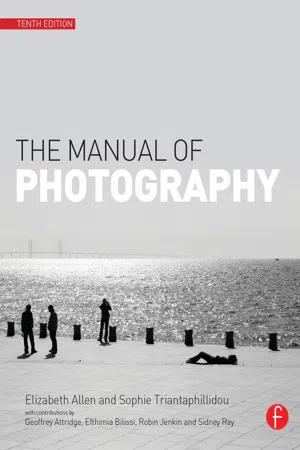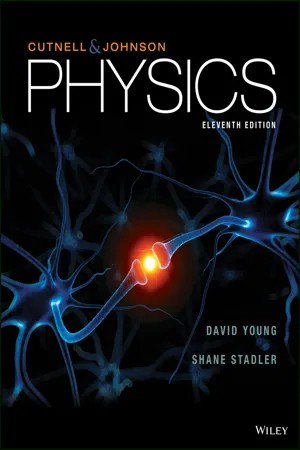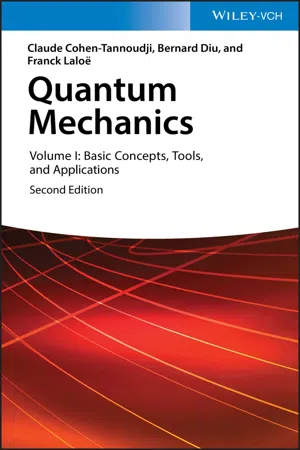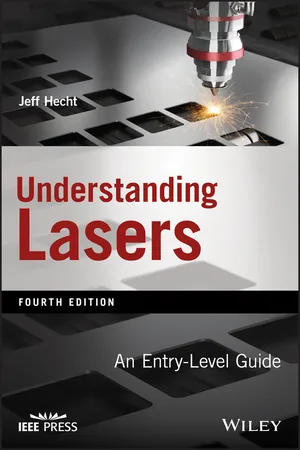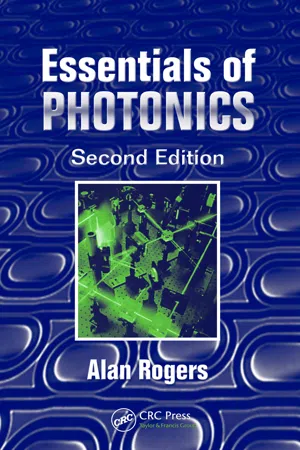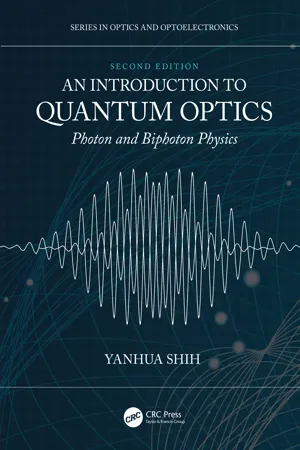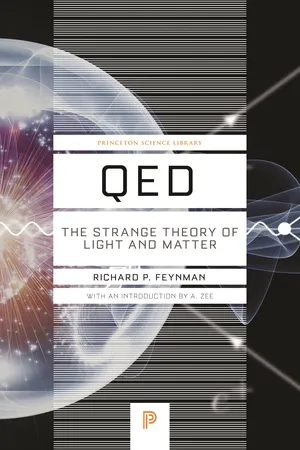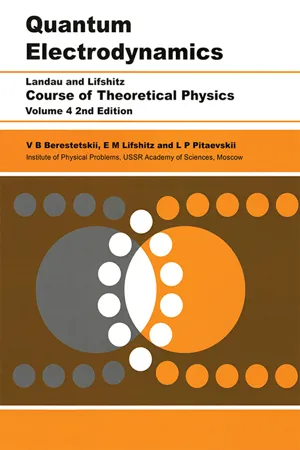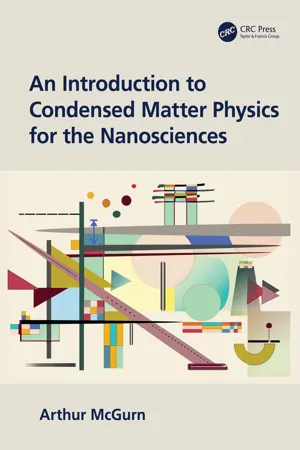Physics
Photons
Photons are fundamental particles of light that carry electromagnetic radiation. They have no mass and travel at the speed of light. In quantum mechanics, photons are considered as both particles and waves, and they play a crucial role in the interaction of light with matter.
Written by Perlego with AI-assistance
Related key terms
Related key terms
1 of 4
Related key terms
1 of 3
11 Key excerpts on "Photons"
- eBook - ePub
Photonics, Volume 1
Fundamentals of Photonics and Physics
- David L. Andrews(Author)
- 2015(Publication Date)
- Wiley(Publisher)
1 A Photon in Perspective David L. AndrewsSchool of Chemistry, University of East Anglia, Norwich, UK1.1 Introduction
It is a familiar, fundamental truth of modern Physics that light is composed of Photons, entities known as elementary particles despite possessing both particle- and wave-like attributes. Readers of these volumes on Photonics will accede with the view that numerous properties and interactions of light are only fully comprehensible when represented and formulated in terms of Photons. Indeed, in order to understand certain processes, there simply appears to be no viable alternative. This is not only the case with observations such as the photoelectric effect that have played a pivotal role in familiar scientific history; in optics there is a wealth of recent and developing applications that also hinge on other, specifically photon-borne properties. Many properties of light appear to manifest directly corresponding attributes of the individual Photons. Other qualities, of course, reflect ensemble characteristics that can emerge only in a beam comprising numerous Photons—but there too we find phenomena dependent on statistical properties which can only make sense by reference to photon distributions. There is a rich and deeply embedded relationship between Photons and the modern science of light.The word photon has not yet reached its centenary; it was in fact coined in 1926 by a thermodynamics researcher named Lewis [1], who surprisingly introduced it to describe “not light but [that which] plays an essential part in every process of radiation.” However, the emergence of a reasonably fully fledged photon concept can be traced back much earlier, to 1905, where it first surfaced in Einstein's explanation of a frequency threshold for photoelectric emission. Using the term Lichtquant - eBook - ePub
From Atoms to Higgs Bosons
Voyages in Quasi-Spacetime
- Chary Rangacharyulu, Christopher J. A. Polachic, Chary Rangacharyulu, Christopher J. A. Polachic(Authors)
- 2019(Publication Date)
- Jenny Stanford Publishing(Publisher)
9 but in which no explanation is forthcoming for its emission and absorption in matter.The concept of the photon, as a discrete energy entity or packet of light, is not very different from that of Isaac Newton, who imagined light to be made up of corpuscular bullets. But in classical Newtonian thinking, there was no association between the frequency of light and its energy. In the quantum concept, this is a chief characteristic of light: the energy of a photon isE = h v (9.2)as originally given by Planck, where h is a constant of Nature. The frequency parameter for light (v ) is a continuous variable, and so is the energy that a photon may have.9.3 Waves and Particles, Real and Virtual
Until very recently, Photons occupied a unique status in particle physics. A “free” photon has zero mass, which makes the energy and momentum numerically the same value. We would recognize this as a kinetic momentum . Another kind of momentum, the canonical momentum , is defined for a photon that is not free, but present within a material medium. As Photons propagate in media, they may exert a push or pull on the material, which can be modeled as an effective mass for the photon. In this context, the canonical momentum is sensitive to the electromagnetic properties of the medium in which the photon is moving.Maxwell’s theory of electromagnetism, combined with the spacetime concepts of Einstein’s relativity as a basic premise, yields a body of theory called electrodynamics . Early developments in quantum theory incorporated Photons as waves, with quantum mechanical representations for the material bodies with which Photons might interact. Photon-matter scattering was described very well by the Klein–Nishina formula , which treats Photons as monochromatic waves of well-defined energy. Following the development of quantum electrodynamics (QED), theorists checked that new theory to see if it agreed with the successful Klein–Nishina formula, although the concept of radiation is ontologically very different in the two frameworks. In QED, matter particles and Photons do not move in space. Rather, when a photon’s position changes from point A to point B, we mathematically destroy one photon at point A and create another at point B.10 This QED process does not obey the principle of causality and leaves the physical system in an energetically unphysical state for a short time interval—an acceptable situation if we invoke Heisenberg’s uncertainty relations. An example of this kind of scenario is the well-known Compton scattering - eBook - ePub
- Elizabeth Allen, Sophie Triantaphillidou(Authors)
- 2012(Publication Date)
- Routledge(Publisher)
Photons differ from other elementary particles such as electrons in that they have zero mass or electric charge and consist purely of energy. When many Photons are present, for example in a light beam, their numbers are so large that the inherent discontinuity or granularity of the light beam disappears and it appears as a continuous phenomenon. The photon can exhibit wave-like behaviour, resulting in phenomena such as refraction or diffraction, described earlier in this chapter. It also behaves as a particle when interacting with matter at a subatomic level, exchanging energy in discrete amounts. The amount of energy E (from Planck’s Law) exchanged during such an interaction is dependent on the frequency of light, and is known as the photon energy. This relationship may be rewritten in terms of the wavelength of the light: where c is the speed of light, h is Planck’s constant, v is the frequency and λ is the wavelength. This means that shorter wavelengths of light will have higher photon energy (see Figure 2.23, which shows the electromagnetic spectrum in terms of wavelength, frequency and photon energy). This becomes important later on, in understanding why imaging materials are sensitive to some wavelengths of light and not others (spectral sensitivity). BOHR MODEL OF THE ATOM In the early twentieth century, the commonly accepted model of the atom was the planetary model of Rutherford in 1911 (Figure 2.29), which consisted of a small densely packed positively charged nucleus, made up of protons and neutrons, about which clouds of negative electrons orbited, like planets around the sun. Rutherford’s model assumed that some outer electrons were loosely bound to the nucleus and could therefore be easily removed by applying energy. There is a problem with this model, however, as follows: the negative charge of the nucleus and the positive charge of the electrons mean that there is an electrostatic attraction between them - eBook - ePub
- John D. Cutnell, Kenneth W. Johnson, David Young, Shane Stadler(Authors)
- 2018(Publication Date)
- Wiley(Publisher)
hf. Einstein made the proposal that light consists of such energy packets.29.3 Photons and the Photoelectric Effect
We have seen in Chapter 24 that light is an electromagnetic wave and that such waves are continuous patterns of electric and magnetic fields. It is not unexpected, then, that light beams, such as those in the photograph in Figure 29.3 , or those coming from flashlights, look like continuous beams. However, we must now discuss the surprising fact that visible light and all other types of electromagnetic waves are composed of discrete particle-like entities called Photons . As discussed in Chapters 6 and 7 , the total energy E and the linear momentump →are fundamental concepts in physics that apply to moving particles such as electrons and protons. The total energy of a (nonrelativistic) particle is the sum of its kinetic energy (KE) and potential energy (PE), orE = KE + PE. The magnitude p of the particle's momentum is the product of its mass m and speed v, orp = mv. We will see that the ideas of energy and momentum also apply to Photons. The defining equations for photon energy and photon momentum, however, are not the same as they are for particles such as electrons and protons.Although the spotlight beams in the photograph look like continuous beams of light, each is composed of discrete Photons.FIGURE 29.3Experimental evidence that light consists of Photons comes from a phenomenon called the photoelectric effect , in which electrons are emitted from a metal surface when light shines on it. Interactive Figure 29.4 illustrates the effect. The electrons are emitted if the light being used has a sufficiently high frequency. The ejected electrons move toward a positive electrode called the collector and cause a current to register on the ammeter. Because the electrons are ejected with the aid of light, they are called photoelectrons - eBook - ePub
Quantum Mechanics, Volume 1
Basic Concepts, Tools, and Applications
- Claude Cohen-Tannoudji, Bernard Diu, Franck Laloë(Authors)
- 2020(Publication Date)
- Wiley-VCH(Publisher)
hv. Einstein showed how the introduction of Photons made it possible to understand, in a very simple way, certain as yet unexplained characteristics of the photoelectric effect. Twenty years had to elapse before the photon was actually shown to exist, as a distinct entity, by the Compton effect (1924).These results lead to the following conclusion: the interaction of an electromagnetic wave with matter occurs by means of elementary indivisible processes, in which the radiation appears to be composed of particles, the Photons. Particle parameters (the energy E and the momentum p of a photon) and wave parameters (the angular frequency ω = 2πυ and the wave vector k, where |k| = 2π/λ, with v the frequency and λ the wavelength) are linked by the fundamental relations:(A-1)where is defined in terms of the Planck constant h:(A-2)During each elementary process, energy and total momentum must be conserved.A-2. Wave-particle duality
Thus we have returned to a particle conception of light. Does this mean that we must abandon the wave theory? Certainly not. We shall see that typical wave phenomena such as interference and diffraction could not be explained in a purely particle framework. Analyzing Young’s well-known double-slit experiment will lead us to the following conclusion: a complete interpretation of the phenomena can be obtained only by conserving both the wave aspect and the particle aspect of light (although they seem a priori irreconcilable). We shall then show how this paradox can be resolved by the introduction of the fundamental quantum concepts.A-2-a. Analysis of Young’s double-slit experiment
The device used in this experiment is shown schematically in Figure 1 . The monochromatic light emitted by the source ℐ falls on an opaque screen 𝓅 pierced by two narrow slits F1 and F2 , which illuminate the observation screen ℰ (a photographic plate, for example). If we block F2 , we obtain on ℰ a light intensity distribution I1 (x) which is the diffraction pattern of F1 . In the same way, when F1 is obstructed, the diffraction pattern of F2 is described by I2 (x). When the two slits F1 and F2 are open at the same time, we observe a system of interference fringes on the screen. In particular, we note that the corresponding intensity I(x) is not the sum of the intensities produced by F1 and F2 - eBook - ePub
Understanding Lasers
An Entry-Level Guide
- Jeff Hecht(Author)
- 2018(Publication Date)
- Wiley-IEEE Press(Publisher)
CHAPTER 2 PHYSICAL BASICS ABOUT THIS CHAPTER Lasers evolved from concepts of modern physics that emerged early in the 20th century. To understand lasers, you need to understand basic concepts including light, atomic energy levels, quantum mechanics, and optics. This chapter starts with the nature of light, then moves on to how light is generated, the interactions of light and matter, and some fundamentals of optics and fiber optics, to give you the background you need to understand lasers themselves. 2.1 ELECTROMAGNETIC WAVES AND Photons Early physicists debated long and loud over the nature of light. In the 17th century, Christian Huygens believed light was made up of waves, but Isaac Newton held that light was made up of tiny particles. Newton's theory was thought to be right for a century, until Thomas Young showed the interference of light, which could only be explained by waves. Today, we know that both theories are partially right. Much of the time, light behaves like a wave. Light is called an electromagnetic wave because it consists of electric and magnetic fields perpendicular to each other, as shown in Figure 2.1. Because the electric and magnetic fields oscillate perpendicular to the direction in which the waves travel, they are called transverse waves. Figure 2.1 Structure of an electromagnetic wave. At other times, light behaves like massless particles called Photons. A photon is a quantum of electromagnetic energy, not the hard particle that Newton envisioned. The quantum view that light comes in discrete chunks rather than a continuous wave is also critical to understanding light. We will move back and forth between the wave and particle views of light, but you should remember that they are just different ways to look at the same thing. We also include some simple formulas, explaining them in words to help you understand what they mean - eBook - ePub
- Alan Rogers(Author)
- 2017(Publication Date)
- CRC Press(Publisher)
The null result of the aether experiment was incorporated by Einstein into an entirely new view of space and time, in his two theories of relativity: the special theory (1905) and the general theory (1915). Light, which propagates in space and oscillates in time, plays a crucial role in these theories.Thus physics arrived (ca. 1920) at the position where light appeared to exhibit both particle (quantum) and wave aspects, depending on the physical situation. To compound this duality, it was found (by Davisson and Germer in 1927, after a suggestion by de Broglie in 1924) that electrons, previously thought quite unambiguously to be particles, sometimes exhibited a wave character, producing interference and diffraction patterns in a wave-like way.The apparent contradiction between the pervasive wave-particle dualities in nature is now recognized to be the result of trying to picture all physical phenomena as occurring within the context of the human scale of things. Photons and electrons appear to behave either as particles or as waves to us only because of the limitations of our modes of thought. We have been conditioned to think in terms of the behaviour of objects such as sticks, stones, and waves on water, the understanding of which has been necessary for us to survive, as a species, at our particular level of things.In fact, the fundamental atomic processes of nature are not describable in these same terms, and it is only when we try to force them into our more familiar framework that apparent contradictions such as the wave-particle duality of electrons and Photons arise. Electrons and Photons are neither wave nor particles but are entities whose true nature is somewhat beyond our conceptual powers. We are very limited by our preference (necessity, almost) for having a mental picture of what is going on.Present-day physics with its gauge symmetries and field quantizations rarely draws any pictures at all, but that is another story.1.3 The Wave Nature of Light
In 1864 Clerk Maxwell was able to express the laws of electromagnetism known at that time in a way that demonstrated the symmetrical interdependence of electric and magnetic fields. In order to complete the symmetry, he had to add a new idea: that a changing electric field (even in free space) gives rise to a magnetic field. The fact that a changing magnetic field gives rise to an electric field was already well known, as Faraday’s law of induction. - eBook - ePub
An Introduction to Quantum Optics
Photon and Biphoton Physics
- Yanhua Shih(Author)
- 2020(Publication Date)
- CRC Press(Publisher)
2Quantum Theory of Light: Field Quantization and Photon
The quantum theory of light began in the early 20th century. The successful introduction of the concept of photon, or light quantum, stimulated a new foundation of physics, namely, the quantum theory. Today, quantum theory has turned out to be the overarching principle of modern physics. It would be difficult to find a single subject among the physical sciences which is not affected in its foundations or in its applications by quantum theory.After 100 years of studies, how much do we know about the photon? The photon is a wave: it has no mass, it travels at the highest speed in the universe, and it interferes with itself. The photon is a particle: it has well-defined values of momentum and energy, and it even “spins” like a particle. The photon is neither a wave nor a particle, because whichever we think it is, we would be tripped into difficulties in explaining the other part of its behavior. The photon is a wave-like-particle and/or a particle-like-wave: a photon can never be divided into parts, but interference of a single photon can be easily observed by modern technologies. It seems that a photon passes both paths of an interferometer when interference patterns are observed; however, if the interferometer is set in such a way that its two paths are “distinguishable”, the photon “knows” which path to follow and never passes through both paths. Apparently, a photon has to make a choice in its behavior when facing an interferometer: a choice of “both-path” like a wave or “which-path” like a particle. Surprisingly, the choice is not necessary before passing through the interferometer. It has been experimentally demonstrated that the choice of “which-path” and/or “both-path” can be delayed until after the photon has passed through the interferometer. More surprisingly, the which-path information can even be “erased” after the annihilation of the photon itself. The behavior of a photon apparently does not follow any of the basic criterion: reality, causality, and locality, of our everyday life. Of course, the peculiarity of wave-particle duality is not only the property of Photons, it belongs to all quanta in the quantum world. Perhaps, it is easy to accept the particle picture of an electron with mass, me, and charge, e; it is definitely not easy to accept the particle nature of a photon. On the other hand, perhaps, it is easy to accept the wave picture of a photon with frequency, ω, and wavevector, k - eBook - ePub
Princeton Science Library
The Strange Theory of Light and Matter
- Richard P. Feynman(Author)
- 2014(Publication Date)
- Princeton University Press(Publisher)
2
Photons: Particles of Light
This is the second in a series of lectures about quantum electrodynamics, and since it’s clear that none of you were here last time (because I told everyone that they weren’t going to understand anything), I’ll briefly summarize the first lecture.We were talking about light. The first important feature about light is that it appears to be particles: when very weak monochromatic light (light of one color) hits a detector, the detector makes equally loud clicks less and less often as the light gets dimmer.The other important feature about light discussed in the first lecture is partial reflection of monochromatic light. An average of 4% of the Photons hitting a single surface of glass is reflected. This is already a deep mystery, since it is impossible to predict which Photons will bounce back and which will go through. With a second surface, the results are strange: instead of the expected reflection of 8% by the two surfaces, the partial reflection can be amplified as high as 16% or turned off, depending on the thickness of the glass.This strange phenomenon of partial reflection by two surfaces can be explained for intense light by a theory of waves, but the wave theory cannot explain how the detector makes equally loud clicks as the light gets dimmer. Quantum electrodynamics “resolves” this wave-particle duality by saying that light is made of particles (as Newton originally thought), but the price of this great advancement of science is a retreat by physics to the position of being able to calculate only the probability that a photon will hit a detector, without offering a good model of how it actually happens.In the first lecture I described how physicists calculate the probability that a particular event will happen. They draw some arrows on a piece of paper according to some rules, which go as follows: - eBook - ePub
Quantum Electrodynamics
Volume 4
- V B Berestetskii, L. P. Pitaevskii, E.M. Lifshitz(Authors)
- 2012(Publication Date)
- Butterworth-Heinemann(Publisher)
CHAPTER I Photons Publisher Summary The lowest energy level of the field corresponds to the case where the quantum numbers of all the oscillators are zero; this is called the electromagnetic field vacuum state. However, even in that state, each oscillator has a nonzero zero-point energy. Summation over an infinite number of oscillators gives an infinite result. The relationship between the photon energy and momentum is as it should be in relativistic mechanics for particles having zero rest-mass and moving with the velocity of light. The Schrödinger’s equation for the photon is represented by Maxwell’s equations. The coordinate wave function of the photon cannot be interpreted as the probability amplitude of its spatial localization. The properties of a quantum system are known to be similar to the classical properties when the quantum numbers defining the stationary states of the system are large. The photon, like any other particle, can possess a certain angular momentum. The polarization vector acts for the photon as the spin part of the wave function. § 2 Quantization of the free electromagnetic field With the purpose of treating the electromagnetic field as a quantum object, it is convenient to begin from a classical description of the field in which it is represented by an infinite but discrete set of variables. This description permits the immediate application of the customary formalism of quantum mechanics - Arthur McGurn(Author)
- 2023(Publication Date)
- CRC Press(Publisher)
5 Basic Properties of Light and Its Interactions with MatterDOI: 10.1201/9781003031987-5In this chapter, an introduction to the quantization of the electromagnetic fields and some of the properties of their interactions with bound electronic systems are presented [1 ,2 ,3 ,4 ,5 ,6 and 7 ]. This involves a treatment along the lines of the Planck and Einstein hypotheses in which the field energies are taken to occur in integer multiples ofℏ ωand in which the degrees of freedom in classical electrodynamics are replaced by quantum mechanical operators characterizing photon excitations of the fields. Specifically, the classical formulation of electrodynamics in terms of a Hamiltonian and its dynamics generated by Poisson brackets is replaced by a quantum formulation in terms of a Hamiltonian operator and its commutator-generated dynamics [8 ,9 ]. This formulation of electrodynamics is then developed to treat the quantum mechanical interaction of the fields with a two-level quantum mechanical model of a single bound electron [3 ,4 ,5 ,6 and 7 ]. In this regard, the basic dynamics of the quantum electron-field system is discussed in the context of the so-called Jaynes–Cumming model [3 ,6 ,7 ]. This model provides a basic treatment of interest for electrons bound in atoms and molecules confined within electromagnetic cavities [3 ,7 ].In addition, discussions are also presented of the basic ideas related to the coherence of the electromagnetic fields [3 ,7 ]. These are made in terms of an infinite set of coherence functions that quantitatively characterize the extent to which the fields are correlated in space and time. Specific considerations are given to the coherence properties of Fock states, coherent states, and thermal distributions of radiation fields [3 ,4 ,5 ,6 and 7 ]. These characterizations will later be of interest in the context of the treatment presented in Chapter 6
Index pages curate the most relevant extracts from our library of academic textbooks. They’ve been created using an in-house natural language model (NLM), each adding context and meaning to key research topics.
Explore more topic indexes
Explore more topic indexes
1 of 6
Explore more topic indexes
1 of 4


